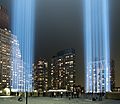Tribute in Light facts for kids

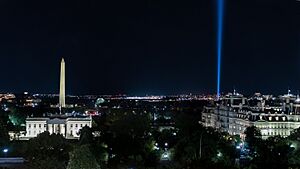

The Tribute in Light is a special art display. It helps us remember the September 11 attacks. These attacks happened in 2001 and were a very sad event for the United States.
The display uses 88 powerful lights. They shine straight up into the sky. These lights form two tall columns. They look like the Twin Towers that once stood in New York City.
You can find the Tribute in Light in New York City. It is located near where the Twin Towers used to be. The lights are placed on top of the Battery Parking Garage.
This tribute started as a temporary display in 2002. But it became an important yearly event. Now, it happens every September 11th. The Municipal Art Society of New York helps put it on.
Many artists helped create this idea. They include John Bennett, Gustavo Bonevardi, Richard Nash Gould, Julian LaVerdiere, and Paul Myoda. Paul Marantz was the lighting expert.
The lights turn on when the sun goes down. They stay on until the sun comes up the next morning. Sometimes, the lights are turned off for 20 minutes. This helps migratory birds fly away safely.
On clear nights, you can see the lights from far away. They are visible up to 60 miles (about 96 kilometers) away. People in all of New York City can see them. They are also seen in parts of Northern New Jersey and Long Island. You can even spot them in Fairfield County, Connecticut, and several New York counties.
Each of the 88 lights uses a lot of power. They are called xenon spotlights. Each one uses 7,000 watts of electricity. Putting on this display costs about $500,000 each year.
Similar light tributes have also appeared. They have been seen at the Pentagon in Virginia. Another was at the crash site of United 93 in Pennsylvania. These places were also affected by the 9/11 attacks.
How the Tribute Started
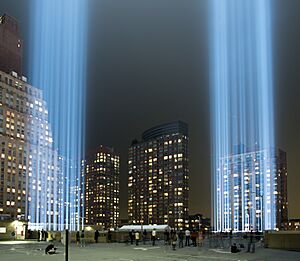
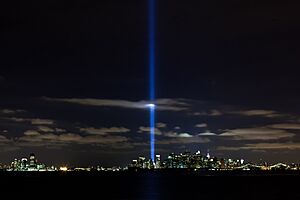

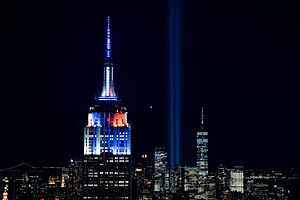
After the sad events of September 11, 2001, many people wanted to create a way to remember. Several individuals thought of using lights. Their ideas came together. The Municipal Art Society and Creative Time helped make it happen.
The Tribute in Light began to be set up on March 11, 2002. It first ran as a temporary display. This was from March 11 to April 14, 2002. It was then shown again on September 11, 2003. This marked the second anniversary of the attacks.
Since then, the tribute has been repeated every year on September 11th. There was talk that 2008 would be its last year. But the tribute continued in 2009. It was confirmed in 2009 that the tribute would continue through 2011.
The National September 11 Memorial & Museum now helps with the tribute. They have taken over running the display. This helps make sure the tribute continues each year.
A company called Space Cannon makes the lights. They send a team every year to help set them up. Another company, Light America, also helped with the project.
About 30 people work for ten days to install the lights. These include technicians, electricians, and stagehands. They test the lights for several days. People in different areas help make sure the beams are aimed correctly.
The project was almost called Towers of Light. But the families of the victims felt this name focused on the buildings. They wanted the tribute to remember the people who were lost.
There was an idea to have a permanent light display. It would have been on top of One World Trade Center. However, this idea was not included in the final building design.
Since 2008, the generators for the lights use special fuel. It is biodiesel made from used cooking oil. This oil comes from local restaurants.
Helping Migratory Birds
The bright lights of the Tribute in Light can affect birds. Over a million migrating birds have become confused by the beams. The lights can trap them. Even birds flying very high can be affected.
Because of this, the lights are turned off for 20-minute periods. This allows the birds to escape the light beams. The Municipal Art Society works with the NYC Bird Alliance. They make sure the lights do not harm migrating birds.
A study in 2017 looked at this effect. It found that the lights changed how birds flew at night. But these changes stopped when the lights were turned off.
Images for kids
-
Tribute in Light as seen from Jersey City in 2020
-
The Pentagon's Tribute in Light seen from the White House in 2021
-
Tribute in Light as seen from Brooklyn in 2014
-
Tribute in Light as seen from atop a parking garage in Battery Park in 2018
-
Tribute in Light as seen from Brooklyn in 2010
-
Tribute in Light as seen from the East Village in 2011
-
As seen from 30 Rockefeller Plaza in 2021
See also
 In Spanish: Tribute in Light para niños
In Spanish: Tribute in Light para niños





